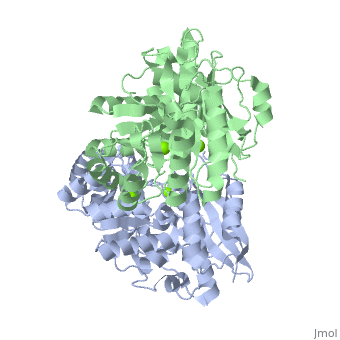Muconate cycloisomerase
Muconate cycloisomerase (MCI) catalyzes the formation of muconolactone from cis,cis-muconate. It is part of the B-ketoadipate pathway in the metabolism of aromatic compounds[1]. MCI breaks down lignin-derived catechol and protocatechuate.
|
| ||||||||||
3D Structures of muconate cycloisomerase3D Structures of muconate cycloisomerase
Updated on 10-November-2021
ReferencesReferences
- ↑ Vollmer MD, Hoier H, Hecht HJ, Schell U, Groning J, Goldman A, Schlomann M. Substrate specificity of and product formation by muconate cycloisomerases: an analysis of wild-type enzymes and engineered variants. Appl Environ Microbiol. 1998 Sep;64(9):3290-9. PMID:9726873
- ↑ Schmidt E, Knackmuss HJ. Chemical structure and biodegradability of halogenated aromatic compounds. Conversion of chlorinated muconic acids into maleoylacetic acid. Biochem J. 1980 Oct 15;192(1):339-47. PMID:7305906
- ↑ Ornston LN. The conversion of catechol and protocatechuate to beta-ketoadipate by Pseudomonas putida. II. Enzymes of the protocatechuate pathway. J Biol Chem. 1966 Aug 25;241(16):3787-94. PMID:5916392
